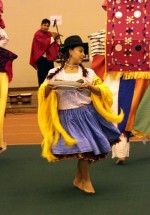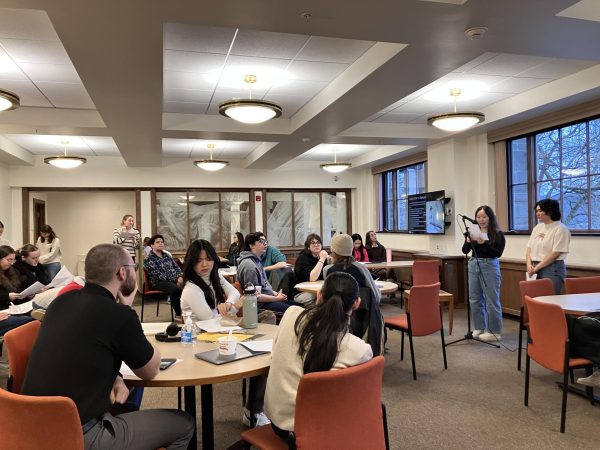The Native American Arts & Culture Festival

For those of us who aren’t members of the track team, visits to the Sanford Field House are few and far between. Students might travel there to hear the featured Global Lecture Series speaker and (hopefully) process down its aisle to receive their diploma during graduation, but they rarely stop by on an ordinary Saturday in the fall. However, this past Saturday proved the exception: students, professors and residents from all over Central New York poured into the Sanford Field House for the annual Native American Arts and Culture Festival.
The festival, which is organized by Colgate’s Longyear Museum of Anthropology, ran from 9:30 a.m. to 5:30 p.m. Activities were scheduled throughout the day and, with so many things to see and do, there was definitely something for everyone. Music and dance performances ran all day and several different dance troupes had the opportunity to perform. The Haudenosaunee Singers and Dancers, who are based in Onondaga, performed a smoke dance and several other lively dances, some of which even called for audience participation. Additionally, there were two new festival appearances this year: The Tlacopan Aztec Dancers, a dance troupe comprised of indigenous Mexican and Canadian Mohawk dancers, and Ayazamana, a group focusing on traditional Ecuadorian music and dance. I arrived in time to see Ayazamana, and they were truly amazing. Dressed in beautifully colorful indigenous costumes, the dancers moved in a way that was both effortless and purposeful, never missing a beat in time with the music.
Artisans were available to provide demonstrations on various processes, from silver working to woodcarving. Mike Tarbell, an educator at the Iroquois Indian Museum, provided me with a very thorough explanation of the different processes of tool-making utilized by Native Americans, some of which originated over 75,000 years ago.
In addition to dancing, music and demonstrations, the festival also offered a large and varied array of handmade items for sale. Vendors of different indigenous backgrounds were present, allowing for an incredibly diverse offering of crafts. Many tables boasted beautiful displays of beaded necklaces, bracelets and earrings in all sorts of shapes, designs and colors. Others displayed leather and cloth bags detailed with intricately threaded designs or embellished with colorful beads. A large stand in the back sold colorful woven sweaters, scarves, hats and mittens. Just next to it was a display of handmade musical instruments for sale.
Many vendors offered carved wooden statues, from the large and abstract to the small and detailed. Others sold beautiful paintings of landscapes and animals. Clay figurines and bowls were also available for purchase. There were woven baskets and dream catchers, wampum belts and moccasins. Every item was beautifully detailed and constructed.
I purposely came with very little cash because I knew how tempted I would be to splurge, but was still able to purchase some “fry bread” (a fried dough-like bread, complete with powdered sugar) for three dollars from one of the food vendors. The generous portion I received provided plenty of bread for both my roommate and I, and we agreed that it was delicious. My friend decided to purchase something more lasting, choosing a stunning handmade silk scarf in a fluorescent orange/pink color. Overall, we all left feeling satisfied with our purchases.
The Native American Arts and Culture Festival isn’t just an excuse to see the Sanford Field House more than once or twice a year. Those who had the privilege of visiting this year know that it’s an amazing opportunity to experience the vibrant and living culture of both local and international indigenous culture.
Contact Betsy Bloom at






